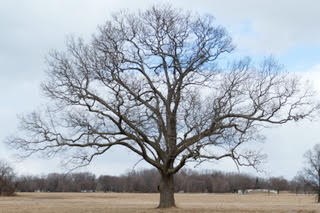Community engagement will guide all decisions, says parks rep

A black walnut tree that has had the benefit of growing out in the open. (Fred Mercnik)
Niagara-on-the-Lake hosts vast swaths of untamed nature, within which live hundreds of species at risk.
Interestingly, nature itself is often the culprit here — with help from humans. Many native trees, for example, are being endangered by their own cousins. The butternut tree grows naturally in Niagara. The Asian butternut tree, however, was brought in, “probably as a quick-growing, good tree for an urban environment,” says resource conservation manager Ken Kingdon of Parks Canada. “The problem is it brought a disease the native butternut couldn’t fight. It also hybridized with the native trees so few pure, native butternut trees remain.”
Parks Canada recently launched the Species at Risk Act, with the goal of protecting hundreds of wild plants and animal species from extinction. They are now looking to engage with the public to help protect this comprehensive list of endangered species including birds, fish, plants, trees, mammals, amphibians, insects, molluscs, and mosses.
This particular plan focuses on the lands around Fort George, the Commons, Paradise Grove and Niagara Shores park — all National Historic Site lands.
Kingdon was accompanied by Gary Allen, species at risk specialist with Parks Canada; Corey Burant, from the Niagara Parks Commission; Jarmo Jalava, a biology consultant; and Paul O’Hara, another consultant, during recent a visit to NOTL. The purpose of the gathering was to connect with local citizens, and enlist their help in protecting endangered species.
There were two parts to the event, all open to the public: an afternoon field visit, and an evening discussion session. The goal of the walkabout, with members of the community, was to immerse people in the environments that support those species. The evening was an opportunity to learn from one another and share ideas.
Both groups exchanged knowledge and insights. “There was so much information being swapped and shared,” says Kingdon with excitement.
“This certainly was a thought-provoking event,” says Chautauqua resident Holmes Hooke. “I was particularly interested in the woods around Firelane 3, an area I visit often. The plan to eradicate the considerable population of invasive species and make room for the endangered native plants and trees is certainly noble and if carried out, this area will be a beautiful sight in 20 years or so,” he says. “From a personal perspective, it is perhaps the only place around here where I can feel totally lost among trees and if it were altered significantly, I’d miss it.”
Kingdon was deeply impressed by the engagement of passionate citizens such as Hooke, who shared his reforestation work with the team.
“There’s a lot of pride in that community,” says Kingdon. “There’s some real excitement about getting involved in the protection of species at risk.”
There was much discussion as well about how the community can participate, and how to get youth and our large volunteer population to engage in conservation activities. With the provincial government’s recent announcement of a review to endangered species laws, it may become increasingly important for citizens to be engaged in the protection of species at risk.
Other ways to engage and practice citizen science include using tools such as iNaturalist. “Monarchs, plant species, any natural element can be reported on iNaturalist, an app which allows you to map sightings, and upload photos,” says Kingdon. “A suite of experts follows the app to confirm any reports.” He continues to explain how Parks Canada and other agencies rely on these resources to be able to track sightings. “These are really important tools. We can make a query in these apps to say, ‘Has anyone seen Monarchs on the Commons in NOTL?’ They’re very useful to us to confirm the health of various species,” he says.
These events were the beginning of a longer conversation, says Kingdon. “Things came up, there was so much enthusiasm. Our staff just looked at each other and said, ‘How do we share this communication with the community?’ That provided an opportunity. We took that home as homework: What is the best way to engage with the community and for them to engage with us?”For the moment, you can find the species at risk action plan by searching “multi-species action plan” at canada.ca. If you have questions and comments about local native species at risk, they can be directed to [email protected].